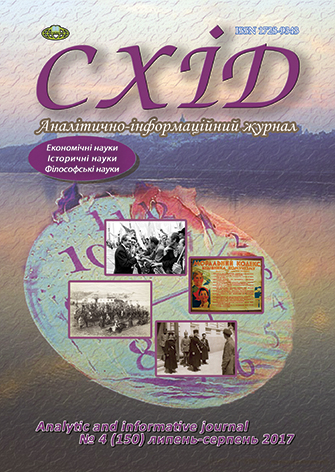Foreign policy benchmarks of Pavlo Skoropadskyi's government (according to archival and autobiographical materials)
DOI:
https://doi.org/10.21847/1728-9343.2017.4(150).111263Keywords:
Pavlo Skoropadskyi, Ukraine, the Hetmanate, foreign policyAbstract
The author reviews some archival documents and materials of Pavlo P. Skoropadskyi, Hetman of the Ukrainian state, his personal memoirs and executive decisions on foreign policy issues over a period of April-December 1918. Pavlo Skoropadskyi's stand as to building the state and his commitment to the pro-Russian vector are demonstrated. Some examples of practical steps taken by Pavlo Skoropadskyi's government to gain understanding with the Entente countries after Germany and Austria-Hungary lost the war are given. Based on its organizational structure, the type of the Hetman state is defined. An example of rapport with new temporary state formations on the Don and Kuban Rivers is given. The paper describes radical and prompt actions of the Hetman government, taken to draw the Crimea under the dominion of Ukraine. The fallacy of the pro-Russian line of policy of Hetman P. Skoropadskyi in the context of the German and Austro-Hungarian occupation is pointed out. The ambiguous course of Ukraine is exemplified by the formation of its Armed Forces, Cabinet of Ministers and delaying in the implementation of the agrarian reform. The attitude of Pavlo Skoropadskyi to the Ukrainians and the Galicians is demonstrated through specific references to his statements. The paper shows some practical steps in opening embassy missions and consular agencies in European countries, which point to the efforts of the Cabinet of Ministers to win international recognition and authority for the Ukrainian state. A situational geopolitical change of the diplomatic relations is demonstrated by the example of Romania. The main causes of the anti-Hetman uprising are defined as the lack of a negotiation process with representatives of socialist and democratic forces of Ukraine, incapability to enlist the support of rural masses and inferior moods in respect of Russia.
Downloads
References
Lytvyn, V.M. (2012), Ukrainein the wars and revolutions of the Twentieth century 1914-1945. Laws of the national state-building process, Naukova dumka, Kyiv, 399 p. (ukr).
Pyrig, R.Ya. (2016), Activities of the Hetmanate’s Governments Pavlo Skoropadsky: Personal Dimension, Institute of History of Ukraine of the National Academy of Sciences of Ukraine, Kyiv, 518 p. (ukr).
Mikhnovsky, M.I. (2002), Independent Ukraine, Diokor, Kyiv, 80 p. (ukr).
Buravchenkov, A.O. (1993), Amnesia of historical memory or something about Hetmanate from the point of view of the present, in: The Last Hetman. Kyiv, pp. 25 - 41 (ukr).
Pyzhyk, A.M. (2004), Development of the national constitutional thought and practice in 1917-1920: modern historiography of the problem, Bulletin of the Kiev University. History. Issue.71-72, Kyiv, pp. 50-52 (ukr).
Borysenko, S.A.(2003), Ukrainian-Russian Relations: April-December 1918, Abstract of thesis for the degree of candidate of Candidate of Historical Sciences, Kyiv, 19 p. (ukr).
Skoropadsky, P. P. & Giric, Igor [ed.] (2016), Memories: the end of 1917-December 1918, Nash format, Kyiv, 480 p. (ukr).
State Bulletin (1918). № 20, 5 July, P.1 .; No. 53, October 3, pp. 1-5, available at: http://www.irbis-nbuv.gov.ua/cgi-bin/irbis_vgf/cg, irbis_64.exe...
Bondarenko, D. (2011), The military potential of the monarchist counterrevolution in 1918: the kingdomof Finland, the UkrainianState, the All-Large army of Donskoy, Military history. No. 6. pp. 44-52 (ukr).
Pyrig, R.Ya. [ed.] and other (2015), Ukrainian state (April-December 1918). Documents and materials. In two volumes, three parts. Vol. 2. Tempora, Kyiv. Pp.124, 135, 145, 228, 306, 331, 344, 346 (ukr).
State Bulletin (1918). №2. 18 May. pp.2. Available at: http://www.irbis-nbuv.gov.ua/cgi-bin/irbis_vgf/cgiirbis_64.exe.
Downloads
Published
How to Cite
Issue
Section
License
Copyright (c) 2017 Bogdan Levyk

This work is licensed under a Creative Commons Attribution-NonCommercial-NoDerivatives 4.0 International License.
1. Authors bear responsibility for the accuracy of facts, quotations, numbers and names used.
2. Manuscripts are not sent back.
3. The publisher does not always agree with the authors' opinion.
4. The authors reserve the right to authorship of the work and pass the first publication right of this work to the journal under the terms of a Creative Commons Attribution-NonCommercial-NoDerivatives 4.0 International License. This license allows others to distribute (copy) the published work for non-commercial purposes, provided there is mandatory attribution to its authors and a link to the first publication in our journal.
5. The authors have the right to conclude separate supplement agreements that relate to non-exclusive work distribution in the form in which it has been published by the journal (for example, to upload the work to the online storage of the journal or publish it as part of a monograph), provided that the reference to the first publication of the work in this journal is included.

